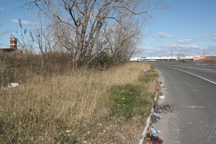Now that the Bayonne Crossing mall has broken ground on the east side of Route 440 between East 22nd Street and New Hook Road, the city is looking at a possible redevelopment of yet another portion of the Route 440 corridor, part of a very hefty agenda that includes additional redevelopment sites throughout the city.
The City Council was expected to vote at its Nov. 10 meeting to request the Planning Board to look at the west side of the highway across from the mall property as a possible area of redevelopment.
“This is one of the redevelopment projects we are looking at.” – John Fussa
________
City Planner John Fussa said this is one of a number of new redevelopment zones being considered for deteriorated or underused sections of the city, areas that are being explored for possible designation under the state’s redevelopment legislation.
“This is one of the redevelopment projects we are looking at,” Fussa said.
Fussa said the site of the former Best Foods Company is also on the agenda for redevelopment, as well as a new scattered site redevelopment plan that would include a number of vacant pieces of property throughout the city.
Four years ago, the city invited developers to review a previous batch of properties in the city outside the former Military Ocean Terminal – which is the largest redevelopment zone in Bayonne.
This review of properties resulted in several dilapidated sites around the city. Fussa said he is hoping to generate similar interest in smaller parcels.
The state’s Local Housing and Redevelopment Law allows local governing bodies to designate areas in need of redevelopment, create partnerships with developers without bids, offer property tax incentives and, if necessary, use eminent domain to acquire properties on behalf of developers.
Although redevelopment zones can be a controversial tool when used to take property in order to raise the tax value of a property already under used, the state law was designed to help municipalities deal with properties that have been abandoned – as in Bayonne, when industry moves on or contamination issues leave properties vacant.
Fussa, who is also working on updating the city’s master plan, said he wants to get these redevelopment issues squared away before he unveils the new document, which will pretty much outline the development future for the city of Bayonne.
Among the city’s existing redevelopment sites – excluding MOBTY – are the former Texaco site near the foot of the Bayonne Bridge, and a Cove Redevelopment site near 21st Street and Newark Bay on the west side of Bayonne.
The 71-acre former Texaco site is slated for redevelopment by K-Land Corp – part of the Kaplan Companies of Highland Park.
Two years ago, Texaco hired Kaplan Companies to remove a long dilapidated pier from the site, part of the first steps toward eventual redevelopment. While some city officials are still cautious in regards to the proposed redevelopment, most believe this is a positive sign, moving toward the aim of turning the unused property into a development that would feature homes, stores, and a waterside walkway. The property would see a mixture of loft and traditional town houses that would emphasize space.
A three block long section along the Newark Bay on dead ends of blocks ranging from West 19th to 21st streets has also been recommended as an area in need of redevelopment.
The area has been vacant for years, and has become a site where people abandoned construction material, cracked traffic cones and old shopping carts.
Called the “Cove Project” as a working title, the properties are known contaminated sites that contain several dilapidated buildings, which could qualify under state law as a redevelopment zone. Redevelopment of the site would connect the pieces of public waterfront walkway, continuing the walk from the piers at the 16th Street Park to an existing segment recently constructed as part of a townhouse project on the north side of West 21st Street.
